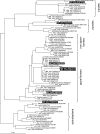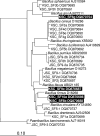Isolation and characterization of bacteria capable of tolerating the extreme conditions of clean room environments
- PMID: 17308177
- PMCID: PMC1855582
- DOI: 10.1128/AEM.03007-06
Isolation and characterization of bacteria capable of tolerating the extreme conditions of clean room environments
Abstract
In assessing the bacterial populations present in spacecraft assembly, spacecraft test, and launch preparation facilities, extremophilic bacteria (requiring severe conditions for growth) and extremotolerant bacteria (tolerant to extreme conditions) were isolated. Several cultivation approaches were employed to select for and identify bacteria that not only survive the nutrient-limiting conditions of clean room environments but can also withstand even more inhospitable environmental stresses. Due to their proximity to spacefaring objects, these bacteria pose a considerable risk for forward contamination of extraterrestrial sites. Samples collected from four geographically distinct National Aeronautics and Space Administration clean rooms were challenged with UV-C irradiation, 5% hydrogen peroxide, heat shock, pH extremes (pH 3.0 and 11.0), temperature extremes (4 degrees C to 65 degrees C), and hypersalinity (25% NaCl) prior to and/or during cultivation as a means of selecting for extremotolerant bacteria. Culture-independent approaches were employed to measure viable microbial (ATP-based) and total bacterial (quantitative PCR-based) burdens. Intracellular ATP concentrations suggested a viable microbial presence ranging from below detection limits to 10(6) cells/m(2). However, only 0.1 to 55% of these viable cells were able to grow on defined culture medium. Isolated members of the Bacillaceae family were more physiologically diverse than those reported in previous studies, including thermophiles (Geobacillus), obligate anaerobes (Paenibacillus), and halotolerant, alkalophilic species (Oceanobacillus and Exiguobacterium). Non-spore-forming microbes (alpha- and beta-proteobacteria and actinobacteria) exhibiting tolerance to the selected stresses were also encountered. The multiassay cultivation approach employed herein enhances the current understanding of the physiological diversity of bacteria housed in these clean rooms and leads us to ponder the origin and means of translocation of thermophiles, anaerobes, and halotolerant alkalophiles into these environments.
Figures


References
-
- Dekas, A. E., C. Moissl, S. Osman, M. T. La Duc, D. Newcombe, and K. Venkateswaran. 2006. The spacecraft assembly facility: a niche for clean room extremophiles, abstr. N = 094, p. 389-390. Abstr. 106th Gen. Meet. Am. Soc. Microbiol. American Society for Microbiology, Washington, D.C.
-
- de Wit, R., and T. Bouvier. 2006. ‘Everything is everywhere, but, the environment selects’; what did Baas Becking and Beijerinck really say? Environ. Microbiol. 8:755-758. - PubMed
-
- Favero, M. S. 1971. Microbiologic assay of space hardware. Environ. Biol. Med. 1:27-36. - PubMed
Publication types
MeSH terms
Substances
Associated data
- Actions
- Actions
- Actions
- Actions
- Actions
- Actions
- Actions
- Actions
- Actions
- Actions
- Actions
- Actions
- Actions
- Actions
- Actions
- Actions
- Actions
- Actions
- Actions
- Actions
- Actions
- Actions
- Actions
- Actions
- Actions
- Actions
- Actions
- Actions
- Actions
- Actions
- Actions
- Actions
- Actions
- Actions
- Actions
- Actions
- Actions
- Actions
- Actions
- Actions
- Actions
- Actions
- Actions
- Actions
- Actions
- Actions
- Actions
- Actions
- Actions
- Actions
- Actions
- Actions
- Actions
- Actions
- Actions
- Actions
- Actions
- Actions
- Actions
- Actions
- Actions
- Actions
- Actions
- Actions
- Actions
- Actions
- Actions
- Actions
- Actions
- Actions
- Actions
- Actions
- Actions
- Actions
- Actions
- Actions
- Actions
- Actions
- Actions
- Actions
- Actions
- Actions
- Actions
- Actions
- Actions
- Actions
- Actions
- Actions
- Actions
- Actions
- Actions
- Actions
- Actions
- Actions
- Actions
- Actions
- Actions
- Actions
- Actions
- Actions
- Actions
- Actions
LinkOut - more resources
Full Text Sources
Other Literature Sources
Molecular Biology Databases

